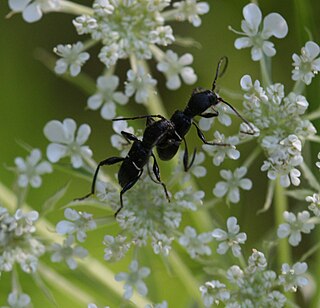Related Research Articles

The longhorn beetles are a cosmopolitan family of beetles, typically characterized by extremely long antennae, which are often as long as or longer than the beetle's body. In various members of the family, however, the antennae are quite short and such species can be difficult to distinguish from related beetle families such as the Chrysomelidae. The family is large, with over 26,000 species described, slightly more than half from the Eastern Hemisphere. Several are serious pests. The larvae, called roundheaded borers, bore into wood, where they can cause extensive damage to either living trees or untreated lumber. A number of species mimic ants, bees, and wasps, though a majority of species are cryptically colored. The rare titan beetle from northeastern South America is often considered the largest insect, with a maximum known body length of just over 16.7 cm (6.6 in). The scientific name of this beetle family goes back to a figure from Greek mythology: after an argument with nymphs, the shepherd Cerambus was transformed into a large beetle with horns.

The Chrysomeloidea are an enormous superfamily of beetles, with tens of thousands of species, mostly in the families Cerambycidae and Chrysomelidae, the leaf beetles.

Chahuis or xamoes are the common names given in Mexico to a variety of edible beetles within the insect order Coleoptera. The insects' common names in English are often "sticks worms", "rhinoceros beetle," or "grub".

Lamiinae, commonly called flat-faced longhorns, are a subfamily of the longhorn beetle family (Cerambycidae). The subfamily includes over 750 genera, rivaled in diversity within the family only by the subfamily Cerambycinae.

Macrodontia is an American genus of long-horned beetles remarkable for their large size and for the large mandibles of the males in particular.

The Disteniidae are a small family of beetles in the superfamily Chrysomeloidea, traditionally treated as a group within the Cerambycidae.

Euderces is a genus of longhorn beetles, family Cerambycidae. They are found in South, Central, and North America, with the centre of diversity in southern Mexico and Guatemala.

The banded hickory borer, Knulliana cincta, is a species of longhorn beetle and the only species in the genus Knulliana. It is about 15–30 mm in length occurring throughout the eastern half of North America, including Mexico and the Bahamas, with one subspecies extending to the Sonoran Desert. If roughly handled it may start to squeak furiously. They are usually found on hickory trees and oak trees, where they lay their eggs; the larvae bore into the trees, sometimes doing significant damage. There are three described subspecies:
Caraphia is a genus of longhorned beetles in the family Cerambycidae, found in Central America.

Trachyderini is a tribe of long-horned beetles in the family Cerambycidae. There are at least 140 genera and 650 described species in Trachyderini.

Parevander xanthomelas is a species of beetle in the family Cerambycidae. It was described by Félix Édouard Guérin-Méneville in 1844, and has been classified in the genus Parevander since the circumscription of that genus by Per Olof Christopher Aurivillius in 1912.

Taeniotes scalatus is a species of flat-faced longhorn beetle in the subfamily Lamiinae of the family Cerambycidae.

Callichroma holochlorum is a species of beetle in the family Cerambycidae. It was described by Bates in 1872. It is known from Mexico, Colombia, and Venezuela. It contains the subspecies Callichroma holochlorum holochlorum and Callichroma holochlorum melancholicum.
Mionochroma vittatum is a species of beetle in the family Cerambycidae. It was described by Johan Christian Fabricius in 1775. It is known from Mexico and central Brazil.

Dryobius sexnotatus is a species of beetle in the family Cerambycidae. It is the only species in the monospecific genus Dryobius.
Callimoxys nigrinus is a species of beetle in the family Cerambycidae. It was described in 2011 under two different spellings, and the authors later selected nigrinus over nigrinis.

Callimoxys is a genus of long-horned beetles in the family Cerambycidae. There are about eight described species in Callimoxys.
Dmytro Zajciw was a Ukrainian and Brazilian entomologist, notable for his collection and for his many beetle discoveries. He was born in Velyka Mykhailivka, Ukraine and died in Rio de Janeiro, Brasil. He was the author of Two new genera and species of neotropical Longhorn beetles , 1957, Contribution to the study of Longhorn beetles of Rio de Janeiro , 1958, and was the first to describe the genera Adesmoides and Pseudogrammopsis, as well as the species Beraba angusticollis and Mionochroma subaurosum, among many others.

Monochamus sargi is a species of beetle in the family Cerambycidae. It was described by Henry Walter Bates in 1885. It is known from Mexico and Guatemala.

Lepturini is a tribe of flower longhorns in the family Cerambycidae. There are at least 50 genera and at least 200 described species in Lepturini.
References
- ↑ Bezark, Larry G. A Photographic Catalog of the Cerambycidae of the World Archived 2018-03-27 at the Wayback Machine . Retrieved on 22 May 2012.
- ↑ Toledo, Víctor H., Angélica Ma Corona, and Juan J. Morrone. "Track analysis of the Mexican species of Cerambycidae (Insecta, Coleoptera)." Revista Brasileira de Entomologia 51.2 (2007): 131-137.
| This Oreodera article is a stub. You can help Wikipedia by expanding it. |